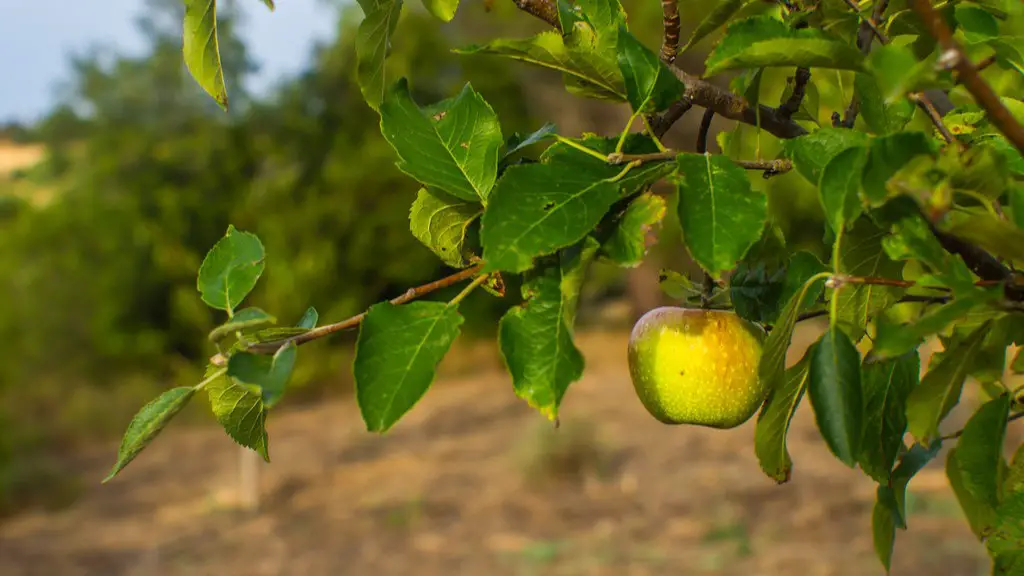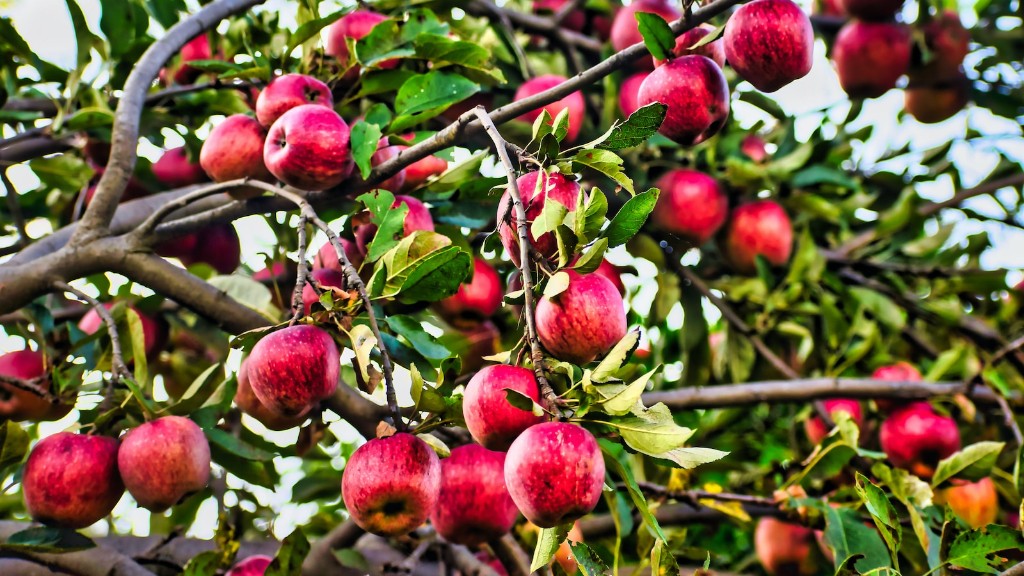When it comes to harvesting apple fruit from a tree, timing is everything. The most common way to judge the ripeness of apples is to pay close attention to their color and texture. Generally, if the apples are a pinkish-green color and still slightly hard to the touch, they are not yet ripe. Conversely, when the apples have turned a bright red hue with a soft, tender texture, they are ready to be picked. Apples also tend to “pop” off the tree when they are ripe and firm pressure with your fingers causes the stem to separate from the tree. Sound is another indicator of an apple’s ripeness; if thumping the apple with your finger produces a solid sound – like a thud – the apple is ripe and ready. If a crisper hollow noise is heard, the apple may need more time on the tree.
In addition to texture and sound, apples that still contain a hint of “starchiness” will often require more time on the tree. To check for starchiness, try pressing an apple’s flesh with your thumb. If this leaves an imprint for a few seconds and the fruit feels firm, it still needs to ripen.
The type of apple variety can also impact harvest time. For instance, some varieties, such as Honeycrisp and Gala, tend to ripen earlier in the season, while other varieties, such as Granny Smith, tend to ripen later in the season. As such, it is important to know the variety and harvest accordingly.
Furthermore, general weather conditions also play a role in ripening time. In terms of temperature, apples generally require outdoor temperatures of approximately 65-85 degrees F to fully ripen. Additionally, ample air circulation and at least an inch of water per week are also necessary for optimal ripening.
Apple Varieties
When it comes to picking apples from the tree, different varieties ripen at different times. For instance, Honeycrisp apples tend to ripen early in the season, while Granny Smith apples tend to ripen later. Therefore, it is important to be aware of the types of apple varieties planted in order to best determine when to pick. Furthermore, some apple varieties have environmental requirements that must be met for ripening, such as ambient temperature, air circulation, and adequate moisture.
Understanding the environmental needs of the apples helps ensure a higher success rate when harvesting. For instance, apples require ample airflow and temperatures between 65-85 degrees F in order to fully ripen. Additionally, they will often require at least an inch of water per week in addition to their natural moisture content. Therefore, apple trees must be kept in an environment that meets all these conditions to promote successful ripening.
Finally, it is important to identify and note the specific ripening times for each apple variety, as this varies among different types. For example, Honeycrisp apples will ripen earlier than Granny Smith apples and should be harvested first. However, timing is still important for all varieties, as harvesting too early or too late can lead to lost or damaged apples.
Color and Texture
In addition to apple variety and environmental conditions, fruit ripeness can also be determined through color and texture. Generally, green apples are unripe and pinkish green apples are close to ripeness. On the other hand, when they turn a bright red hue, they are deemed ripe. Furthermore, apples tend to “pop” off the tree when they are ready to be harvested. Additionally, they should be firm to the touch but not hard. If an apple is still hard to the touch, it likely requires more time on the tree.
Furthermore, water or juice can often indicate whether an apple is ripe. If the juice inside the apple is clear, then it is likely ready to be picked. If it is still cloudy, then the apple likely needs more time. Additionally, the skin should also be smooth and slightly glossy, never bruised or blotchy. Therefore, if apples are firm to the touch and contain a clear juice, then it is likely ripe enough to be harvested.
Lastly, sound is another indicator of an apple’s ripeness. When firm pressure is applied to an apple, if thumping the apple with your finger produces a solid sound – like a thud – then it is ripe. On the other hand, if a more hollow sound like a “ting” is heard, then the apple needs more time to ripen.
Starch Water Test
The starch water test is a simple way to determine whether apples are ripe enough to be picked. With this test, apply firm pressure to the apple with your thumb. If the flesh leaves an imprint and the flesh is still firm, then the apple has more starch content and needs more time on the tree. If leaving an imprint is difficult and the flesh easily gives when pressed, then it is likely ripe and ready for harvest.
It is also important to remember to limit the amount of time apples spend off the tree. Essentially, once the apples are harvested, it is important to keep them chilled. If the apples are left at room temperature for more than a few hours, they may start to rot and should be discarded. Therefore, immediate refrigeration of harvested apples is essential for optimal shelf life.
Finally, apples can be harvested with or without the stem. Generally, apples that have stems attached to them during harvest will retain more flavor than those without stems. Additionally, leaving the stem can also help protect the apple from bruising during transport, reducing overall detriment to the fruit. Therefore, leaving stems attached is ideal, provided they separate from the tree with minimal effort.
Storage and Shelf Life
Harvesting apples requires thorough knowledge of ripeness and storage methods to ensure optimal quality and shelf-life. It is important to note that apples can be stored at room temperature for a few days, but should then be immediately refrigerated for longer-term storage. Furthermore, it is important to be aware that once apples have been harvested, their shelf-life will decrease over time.
Additionally, apples should also be stored away from other fruits in order to prevent the other fruits from spoiling prematurely. Therefore, apples must be stored in an area with ample airflow and space between the other fruits and vegetables.
In terms of packing apples, it is important to be aware that over-packing them during transport can damage the fruit. As such, it is important to ensure ample space between the apples for optimal air flow during transport. Additionally, stacking or layering apples is also a great way to protect them from bruising.
Lastly, proper storage and transport of apples is key to keeping them from going bad. If apples are stored in a humid or hot environment, the environment itself will cause the apples to spoil faster. Additionally, apples should also be kept away from direct sunlight and food containers must be regularly inspected for signs of spoilage.
Tips for Harvesting
When harvesting apples from the tree, it is important to consider a few tips in order to ensure the highest quality of fruit. First and foremost, it is important to wear proper safety equipment when harvesting, such as gloves and long sleeves. This helps protect the apples from bacteria and damage, while also protecting the picker from any potential critters.
Furthermore, always pick the apples with tweezers or with your fingernails as opposed to your full hand. Apples are particularly fragile and can easily be bruised if handled too forcefully. Additionally, use a soft touch when harvesting fruit to ensure they remain intact while also avoiding any wasted apples.
Finally, inspect each apple before placing it in a container. Even if all the apples in the bucket seem to be healthy, inspect each and every one for signs of damage or bruises. Damaged apples can quickly ruin entire batches, so it is important to take extra caution and inspection for quality control.




